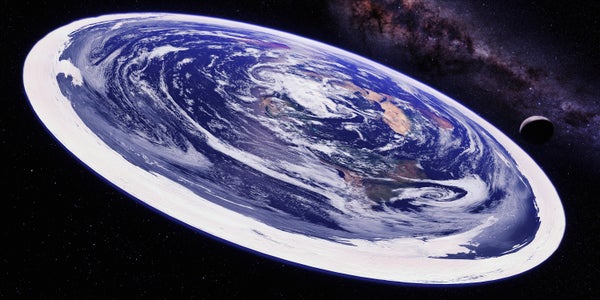This article was published in Scientific American’s former blog network and reflects the views of the author, not necessarily those of Scientific American
In the United Kingdom, as in the United States, flat-Earthers are like catnip to journalists, rendering them exuberant and playful, even to the point of carelessness. In 2018, for example, when a team of itinerant flat-Earthers visited Cambridge to proselytize, using “the mathematics of spherical trigonometry,” Anna Savva of Cambridgeshire Live bemusedly reported, “The friends [Harry McDonald and Jason Disbury] and Harry’s dog have been touring the UK and Ireland in a bus since September 13 and say they have collected 200 pieces of evidence which prove their counter-argument.” (She buried the lede here: a talking dog?)
It ought not to come as a surprise that there are flat-Earthers in the U.K., especially in Cambridgeshire, where the founder of the modern flat-Earth movement, Samuel Birley Rowbotham (1816–1884), became convinced that the planet was not a globe. After he expounded his views in Zetetic Astronomy, published under the pseudonym “Parallax,” a parade of his followers—including John Hampden, who debated Alfred Russel Wallace about the shape of the Earth; Lady Blount, who wrote a wish-fulfillment novel featuring flat-Earthery; and Samuel Shenton, who established the International Flat Earth Research Society—kept the flat Earth in the British public eye.
Despite the evergreen appeal of flat-Earth stories, the prevalence of flat-Earth belief among the general public is still something of a mystery. In what seems to have been the first systematic attempt to assess the American population’s views on the shape of the Earth, a YouGov poll of Americans conducted in 2018 suggested that “2 percent of Americans resolutely say the earth is flat.” When Craig A. Foster and I asked YouGov for the data, however, we received a spreadsheet containing data that diverged from the data in YouGov’s press release. According to the spreadsheet data, only about 1.3 percent of respondents agreed with “I have always believed that the world is flat.”
On supporting science journalism
If you're enjoying this article, consider supporting our award-winning journalism by subscribing. By purchasing a subscription you are helping to ensure the future of impactful stories about the discoveries and ideas shaping our world today.
Recently, on the opposite side of the Atlantic, the British division of YouGov announced that according to a February 2019 poll, 1 percent of Britons regard “The Earth is flat” as definitely true, while 2 percent regard it as probably true. Accompanying the announcement were the results broken out by gender and age. Women were slightly less likely to accept that it was definitely false and slightly more likely to say that they didn’t know than were men; respondents between 18 and 24 were slightly more likely to say that they didn’t know than were older respondents—although, to their credit, none of the youngsters apparently thought that it was definitely true.
The British poll’s question (whether “The Earth is flat” is definitely true, probably true, probably false or definitely false) was straightforward, as opposed to the American poll’s question, which awkwardly combined issues about past beliefs and present doubts. And although the British poll surveyed only 2,039 respondents, while the American poll surveyed either 8,215 (according to the press release) or 10,374 (according to the spreadsheet), the difference is not hugely impressive. The results from the American poll have a lower margin of error, but not that much lower: the margin of error is inversely proportional not to the sample size but to its square root.
As YouGov’s headline “Which science-based conspiracy theories do Britons believe?” suggests, the respondents to the British poll were answering questions about beliefs linked with conspiracy theories (e.g., “The moon landing was staged”). In 2014, political scientists Eric Oliver and Thomas J. Wood reported on a 2011 survey that similarly included questions about conspiracy theories—among them a newly invented theory about compact fluorescent light bulbs constituting a sinister instrument for government control of the populace. Yet 17 percent of respondents indicated that they were familiar with the theory and 10 percent indicated that they agreed with it.
So, could it be that the respondents in the British poll who indicated that they regarded it as definitely true that the Earth is flat did so not because they are committed flat-Earthers but because the battery of questions triggered in them a predisposition to accept conspiracy theories in general? Would they also have indicated that they regarded the sinister compact fluorescent light bulb theory invented by Oliver and Wood as definitely true? The fact that the American poll found a similar percentage of committed flat-Earthers among its respondents suggests otherwise, but it would be preferable to test the hypothesis directly in a future poll.
A popular anti–flat-Earth meme declares, “If the Earth was flat, cats would have pushed everything off it by now.” (As a joke, it’s amusing; as a riposte, it’s not exactly devastating. The mainstream flat-Earth view is that there is a wall of ice at the Earth’s rim, which is presumably impervious to bric-a-brac. There’s also a faction of flat-Earthers who regard the Earth as an infinite flat plane, off which a finite cat couldn’t push anything.)
What the American and British YouGov polls seem to suggest, despite their limitations, is that it would be a mistake to push away the evidence that a small but detectable percentage of us indeed think that the Earth is flat.
